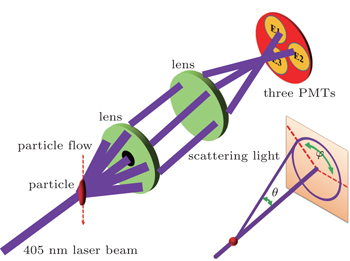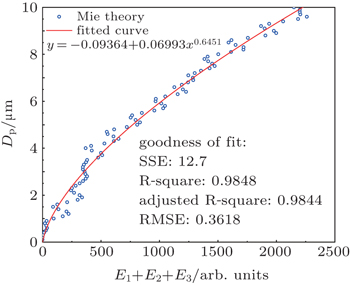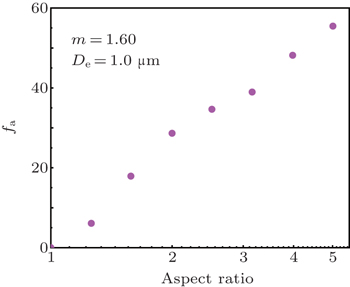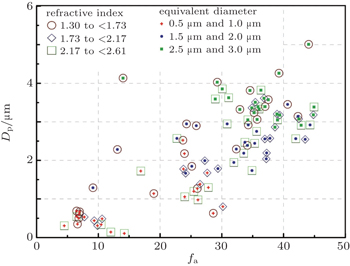† Corresponding author. E-mail:
Project supported by the National Natural Science Foundation of China (Grant No. 41275132).
Particle shape contributes to understanding the physical and chemical processes of the atmosphere and better ascertaining the origins and chemical compositions of the particles. The particle shape can be classified by the aspect ratio, which can be estimated through the asymmetry factor measured with angularly resolved light scattering. An experimental method of obtaining the asymmetry factor based on simultaneous small forward angle light scattering and aerodynamic size measurements is described briefly. The near forward scattering intensity signals of three detectors in the azimuthal angles at 120° offset are calculated using the methods of T-matrix and discrete dipole approximation. Prolate spheroid particles with different aspect ratios are used as the shape models with the assumption that the symmetry axis is parallel to the flow axis and perpendicular to the incident light. The relations between the asymmetry factor and the optical size and aerodynamic size at various equivalent sizes, refractive indices, and mass densities are discussed in this paper. The numerically calculated results indicate that an elongated particle may be classified at diameter larger than 1.0 μm, and may not be distinguished from a sphere at diameter less than 0.5 μm. It is estimated that the lowest detected aspect ratio is around 1.5:1 in consideration of the experimental errors.
Airborne particles, either naturally occurring or man-made, play important roles in the climate effects, atmospheric physical and chemical processes, and human health.[1–3] When investigating the morphologies, concentrations, sources, and chemical compositions of airborne particles in order to estimate their health risks and climatic impacts, the particle shape and size are important parameters by which it is possible to differentiate or even identify some kinds of particles.
Optical scattering techniques,[4] which provide the ideal means of rapid, nondestructive, and in situ particle detection, are popular methods for classifying and possibly identifying airborne particle categories by the shape and size information that can be retrieved from the angular-resolved spatial scattering intensity or the two-dimensional angular optical scattering (TAOS) patterns of aerosol particles. For example, two-dimensional angular optical scattering patterns of nearly 6000 atmospheric aerosol particles were measured by Aptowicz et al. using a TAOS setup which collected polar scattering angles varying from approximately 75° to 135° and azimuthal angles varying from 0° to 360°.[5] Their experimental results demonstrated that single-particle measurements collected from an urban aerosol can be qualitatively classified into general shape categories.[6] Compared with the two-dimensional angular optical scattering system, a real-time high-speed monitoring system, which measured the scattering intensity signals from three miniature photomultiplier tubes placed at equally spaced intervals around the optical axis and a single forward photomultiplier tube, was developed by Kaye et al. earlier for detecting the shape and size characteristics of airborne particles.[7] The particle size characteristic was obtained through the summation of the scattering intensities of the four detector channels and the particle shape was related to the particle asymmetry derived from the response signals of three detector arrangements. 10000 particles were analyzed by Kaye’s instrument per second. Following the extraordinary speed advancement, a novel setup named WIBS-4[8] was designed for the biological aerosol detection by University of Hertfordshire in the United Kingdom, which combined spatial scattering light measuring with UV light-induced fluorescence. Although the development and testing of the WIBS-4 are continuous, its early measuring results[8–10] substantiate that the probable advantages of combining the measurements of shape, size, and intrinsic fluorescence in enhancing particle discrimination ability will be achieved.
Particle size information provided by the experimental apparatus mentioned above is the optical particle size. However, the optical diameter, which retrieves from the theoretical response of the detector channels to scattering from perfect homogeneous spheres of known refractive index, is dependent on the particle size, the refractive index, as well as the experimental system. What is worse, the optical diameter is obtained without considering the influence of the absolute intensity of the incident light so that the optical diameter has a strong uncertainty and poor comparability. It is a common phenomenon that the response curve has a multivalued characteristic, as the particle diameter and the refractive index increase.[11] The multivalued characteristic is scarcely eliminated exactly in elastic light scattering. Besides, the dispersion of scattering intensity belonging to the change of refractive index may result in a harmful effect on classifying particles according to the scattering intensity analysis.
In order to discriminate the morphological characteristics of particles better, an experimental device is proposed, which has the ability of measuring the angular-resolved scattering intensity and the aerodynamic size of a single airborne particle simultaneously. To my knowledge, such an instrument has not been developed so far. For the purpose of classifying airborne particles, the performance of combining spatial azimuthal scattering intensity with aerodynamic size is estimated theoretically in this study.
Many optical systems for measuring azimuthal scattering at a single polar angle have been developed at the University of Hertfordshire in the last twenty years.[12–14] There are some optical designs to collect wide spatial angles’ scattering as well as low forward angles’ scattering. Comparing with the two kinds of designs, it is easier to detect the small forward scattering light intensity. For the purpose of application, we prefer collecting forward elastic scattering light. A part of the experimental instrument is shown in Fig.
When the light scattered through the aperture is collected by a photomultiplier tube, the magnitude E of the electrical signal is proportional to the partial light scattering cross section of the particle



The Mueller matrix of a single nonspherical particle is principally a complex function of size, refractive index, shape, and orientation. However, Hirst et al. concluded that the sample airflow delivery system can aid alignment of elongated particles parallel to the flow direction.[19] In this way, all the scattering intensity data are calculated in the vertical orientation with respect to the axis of illumination for elongated particles.
We utilize an asymmetry factor (fa)[7] to retrieve the particle shape. It is one of the simplest methods of obtaining particle shape through light scattering pattern data. The principle of the calculation of fa is illustrated in Fig.

The optical size (Dp) is an ascribed spherical equivalent size. For particle optical size determination, the instrument uses a calibration approach based on a curve which assumes that the particles are spherical and of a specific refractive index (Mie theory).[20] The scattering intensity data of polystyrene latex (PSL) microspheres with a refractive index 1.58 are used to obtain the calibration curve. A total of one hundred different sizes of PSL within the size range from 0.1 μm to 10 μm are introduced to the instrument for calibration. Figure
In order to obtain the aerodynamic sizes of airborne particles, the flight time of a single particle flowing between dual beams of the light of 650 nm wavelength is measured. This process is calibrated by the TSI APS 3321.[21] The aerodynamic diameter Da is related to the volume equivalent diameter De by the following equation:[22]


The spheroidal models have a wide application of simulating the light scattering characteristics of mineral dust[24] and biological spores.[25] In order to study the relationship between the particle shape and fa, prolate spheroids with different aspect ratios are considered. Figure
For a particle with known shape and aspect ratio, the measured fa could be quite different at different optical or aerodynamic size, since the physical size, the refractive index, and the mass density may vary among the particles. Here we present calculated results of a spheroidal particle with aspect ratio 2:1 at various physical parameters under current experimental configuration.
Figure
Under the same circumstances, by considering different mass densities, the relation between fa and the aerodynamic size is shown in Fig.
Since the aerodynamic size is close to the real physical size of a particle (proportional to the square root of mass density), the particle shape should be close to a sphere if a small fa is measured with an aerodynamic diameter greater than 1.0 μm and maybe nonsphere with an aerodynamic diameter less than 0.5 μm. On the other hand, the aerodynamic size may indicate the type of particle, which restricts the refractive index or mass density to some extent, and help identify its shape. For better classification of the particle shape with fa, the angularly resolved scattering system may be optimized focusing on small particles, e.g., particles of 0.5 μm diameter.
The effects of refractive index, equivalent diameter, and mass density on the shape classification of particles are discussed in this part. As shown in Fig.8, we compute four prolate spheroidal particles with aspect ratios of 1.26:1, 1.58:1, 2.0:1, and 2.51:1 by using the T-matrix method. For each shape, the equivalent diameter varies from 0.5 μm to 3.0 μm in steps of 0.5 μm, the refractive index changes from 1.3 to 2.6 with 13 intervals, and the mass density has values of 1.0 g/cm3, 2.0 g/cm3, and 3.0 g/cm3.
The results in Figs.
Generally, many aerosol types have some specific size and shape characteristics in the atmospheric environment. For example, the crystallized riboflavin has a fiber-like morphology with a typical aspect ratio of 8:1,[26] sodium chloride (NaCl) has a cubic shape, the shapes of mineral hematite particles are approximately prolate spheroid with a typical aspect ratio of 3:1,[27] and some bacterial aerosols[28] are prolate ellipsoidal in shape as well. Table
| Table 1. Summary of the five aerosol types. . |
Figure
A method of measuring shape and size of individual particles by three detectors in the forward scattering polar angle range of 5°–20° and azimuthal angles at 120° offset is described. The responding characteristics of the detectors are calculated using methods of T-matrix and DDA at various physical parameters of a particle, such as optical size, aerodynamic size, equivalent size, refractive index, and mass density. Given some degree of control over the particle orientation in the sample airflow delivery system, just an ideal fixed orientation of the elongated particle is considered. The aspect ratio of an elongated particle can be estimated through three signal intensities, which are used to calculate the asymmetry factor. The relation between the aspect ratio and the asymmetry factor is determined by many parameters.
The calculation results indicate that elongated particles may be distinguished from spherical ones at diameter larger than 1.0 μm, and may not be distinguished from a sphere at diameter less than 0.5 μm. It is estimated that the lowest detected aspect ratio is around 1.5:1 in consideration of the experimental errors.
The aerodynamic size may help identifying the shape since a larger particle presents a fairly larger asymmetry factor related to the aspect ratio. For better classifying particle shape with fa, the angularly resolved scattering system may be optimized focusing on small particles, e.g., particles of 0.5 μm diameter.
Shape and size measurements at single particle level are useful for discriminating biological aerosols in ambient environment.[8–10] It is feasible to combine fluorescence signatures with spatial scattering intensity using one 405 nm laser and to develop a new biological aerosol monitoring apparatus.
| 1 | |
| 2 | |
| 3 | |
| 4 | |
| 5 | |
| 6 | |
| 7 | |
| 8 | |
| 9 | |
| 10 | |
| 11 | |
| 12 | |
| 13 | |
| 14 | |
| 15 | |
| 16 | |
| 17 | |
| 18 | |
| 19 | |
| 20 | |
| 21 | |
| 22 | |
| 23 | |
| 24 | |
| 25 | |
| 26 | |
| 27 | |
| 28 | |
| 29 | |
| 30 | |
| 31 |











